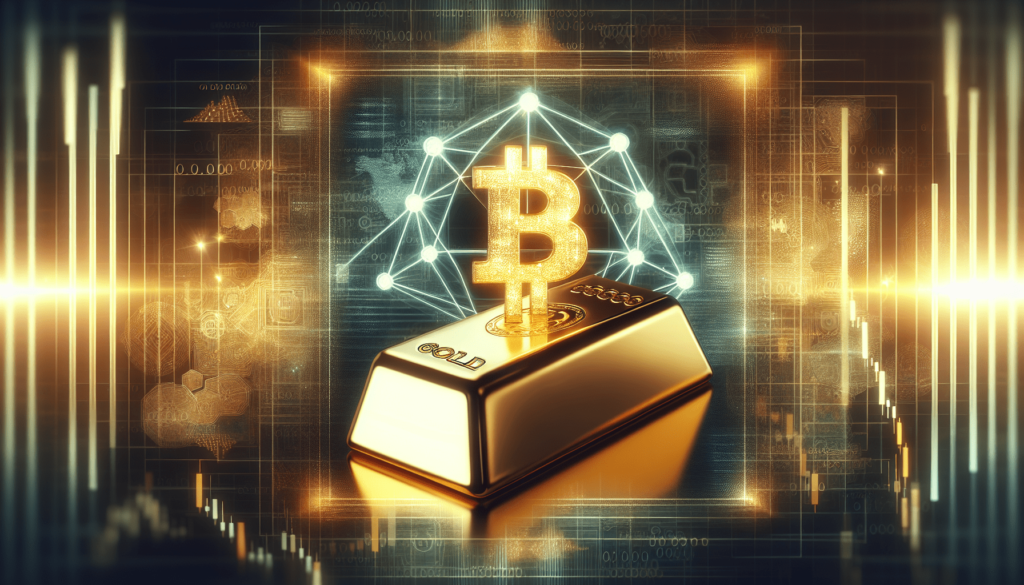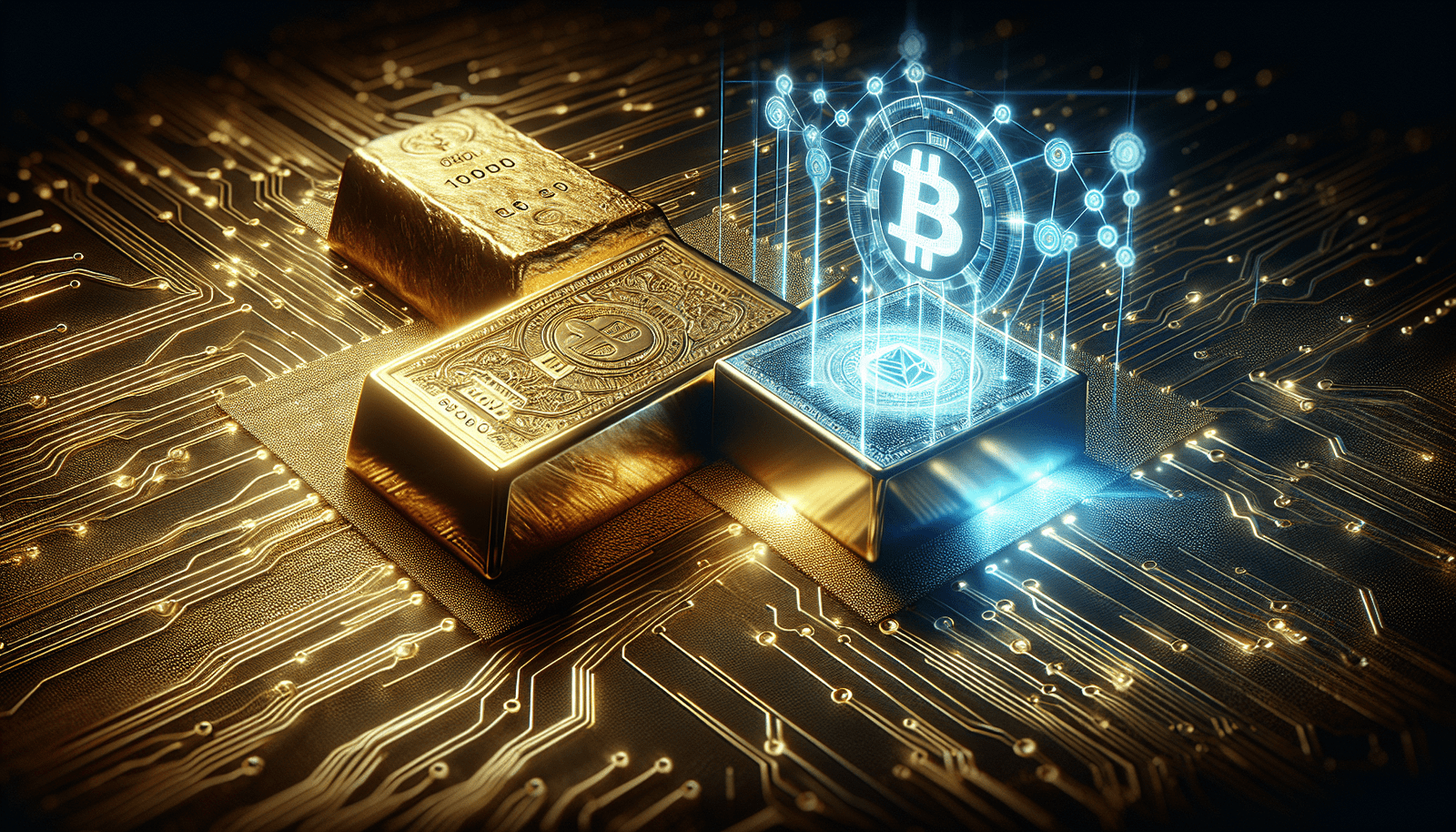Welcome to an exciting article on the convergence of gold and blockchain technology! In today’s fast-paced digital world, the traditional value of gold is meeting the innovative capabilities of blockchain technology. This unique combination is creating new opportunities for investors and reshaping the way we think about the age-old asset of gold. Join us as we explore how these two elements are coming together to revolutionize the financial landscape.
Have you ever wondered how traditional assets like gold can be integrated into modern technology like blockchain?
If you have ever questioned how two seemingly different worlds can collide, the convergence of gold and blockchain technology might just be the answer. In this article, we will explore how these two powerful entities are coming together to create innovative solutions in the digital age.

Understanding Gold as a Timeless Asset
Gold has been synonymous with wealth and value for centuries. Its intrinsic properties, scarcity, and widespread acceptance have made it a go-to asset for investors looking to hedge against inflation and economic uncertainties.
When you think of gold, you may envision jewelry, coins, or even bars stored in vaults. However, gold is much more than a shiny metal – it holds cultural significance, historical value, and practical uses in various industries.
The Appeal of Gold
The appeal of gold lies in its ability to retain value over time. Unlike fiat currencies that can be affected by economic policies and inflation, gold is a finite resource that cannot be duplicated or devalued at will. This makes it a reliable store of wealth and a safe-haven asset during times of market volatility.
Practical Uses of Gold
Beyond its role as a form of wealth preservation, gold has practical applications in industries such as technology, healthcare, and aerospace. Its excellent conductivity, resistance to corrosion, and malleability make it ideal for manufacturing electronic components, medical devices, and spacecraft.
Introducing Blockchain Technology
On the other hand, blockchain technology is a relatively new concept that has taken the world by storm. Best known as the underlying technology behind cryptocurrencies like Bitcoin, blockchain is a decentralized and transparent ledger system that records transactions securely and immutably.
What is Blockchain?
Blockchain is a distributed database that maintains a continuously growing list of records called blocks. Each block contains a timestamp and a link to the previous block, creating a chain of blocks – hence the name blockchain. This technology enables peer-to-peer transactions without the need for intermediaries, making it efficient, secure, and versatile.
Key Features of Blockchain
Some key features of blockchain technology include decentralization, transparency, immutability, security, and programmability. By removing centralized authorities and enabling trustless interactions, blockchain has the potential to revolutionize various industries beyond finance.
The Convergence of Gold and Blockchain
Now, let’s explore how the convergence of gold and blockchain technology is shaping the future of finance, investment, and asset management. By combining the timeless value of gold with the innovative capabilities of blockchain, new opportunities and solutions are emerging for investors and businesses alike.
Tokenization of Gold Assets
One of the most significant developments in the intersection of gold and blockchain is the tokenization of gold assets. Tokenization involves the representation of physical assets like gold on a blockchain in the form of digital tokens. These tokens are backed by physical gold stored in secure vaults, providing investors with a convenient and cost-effective way to own and trade gold.
Tokenized gold assets offer fractional ownership, instant liquidity, transparency, and security compared to traditional gold investments. Investors can buy, sell, and transfer digital gold tokens 24/7 without the need for intermediaries, paperwork, or physical custody. This democratizes access to gold investments and opens up new markets for retail and institutional investors worldwide.
Gold-backed Cryptocurrencies
In addition to tokenized gold assets, there are gold-backed cryptocurrencies that combine the stability of gold with the blockchain technology of cryptocurrencies. These digital tokens are pegged to the value of physical gold at a fixed ratio, allowing holders to redeem their tokens for gold or trade them on various platforms.
Gold-backed cryptocurrencies provide the benefits of both gold and blockchain, such as price stability, instant transfers, global accessibility, and programmable features. They offer an alternative to fiat-backed stablecoins and pure cryptocurrencies, catering to investors looking for a secure and reliable digital asset with intrinsic value.
Benefits of Combining Gold and Blockchain Technology
The convergence of gold and blockchain technology brings a host of benefits to investors, businesses, and the broader economy. By leveraging the strengths of both assets, new possibilities and efficiencies are unlocked, transforming the way we perceive and interact with gold in the digital age.
Diversification and Risk Management
Gold has long been considered a safe-haven asset and a diversification tool for investment portfolios. By tokenizing gold assets on blockchain platforms, investors can diversify their holdings across different asset classes, reducing risk and enhancing overall portfolio performance.
Increased Transparency and Security
Blockchain technology offers transparency, traceability, and security features that are essential for tracking and verifying gold transactions. By recording gold ownership, provenance, and storage on a blockchain, stakeholders can ensure the authenticity and integrity of gold assets, mitigating fraud, theft, and counterfeit risks.
Accessibility and Inclusion
The digitization of gold through blockchain technology opens up opportunities for financial inclusion and access to new markets. Investors who were previously unable to own physical gold due to cost, storage, or regulatory constraints can now participate in gold investments through digital tokens and cryptocurrencies, leveling the playing field for all.
Efficiency and Cost Savings
Blockchain-powered gold solutions streamline the process of buying, selling, and transferring gold assets, reducing intermediaries, paperwork, and transaction costs. By leveraging smart contracts and decentralized platforms, investors can trade gold tokens instantly, settle transactions in real-time, and automate compliance and reporting requirements.

Real-World Applications of Gold and Blockchain Integration
As the convergence of gold and blockchain technology gains momentum, real-world applications and use cases are emerging across various industries and sectors. From supply chain management to wealth management, these innovative solutions are revolutionizing traditional practices and paving the way for a new era of digitized gold assets.
Gold Supply Chain Traceability
Blockchain technology is revolutionizing the supply chain management of gold by enabling transparency, traceability, and accountability throughout the entire lifecycle of gold production and distribution. Companies can track the origin of gold, verify its authenticity and ethical sourcing, and ensure compliance with regulatory standards, reducing the risk of fraud and human rights abuses in the gold supply chain.
Gold-backed Lending and Borrowing
Gold-backed cryptocurrencies can serve as collateral for lending and borrowing activities, providing a secure and stable asset for borrowers and lenders. Through decentralized finance (DeFi) platforms, individuals and businesses can access liquidity, earn interest, and leverage their digital gold holdings without the need for traditional financial institutions.
Tokenized Gold Jewelry and Collectibles
Artisans and designers are creating tokenized gold jewelry and collectibles that combine the physical beauty of gold with the digital uniqueness of blockchain. By tokenizing limited-edition pieces on blockchain platforms, creators can authenticate their designs, protect against counterfeiting, and offer fractional ownership to collectors and investors worldwide.
Challenges and Considerations in Integrating Gold and Blockchain
While the convergence of gold and blockchain technology holds immense promise and potential, there are also challenges and considerations that need to be addressed to ensure a successful integration and adoption in the market. From regulatory compliance to cybersecurity risks, these factors play a crucial role in shaping the future of digital gold assets.
Regulatory Compliance
Regulatory frameworks and guidelines around tokenized gold assets and gold-backed cryptocurrencies vary by jurisdiction, posing challenges for market participants and investors. Ensuring compliance with anti-money laundering (AML) and know-your-customer (KYC) regulations, tax implications, and investor protection standards is essential for the widespread adoption of digital gold assets.
Cybersecurity Risks
As digital assets become more prevalent in the financial landscape, cybersecurity risks and threats are a growing concern for investors and businesses. Protecting gold assets stored on blockchain platforms from hacking, theft, and fraud requires robust security measures, multi-signature wallets, cold storage solutions, and continuous monitoring of vulnerabilities and attacks.
Market Volatility and Liquidity
While tokenized gold assets offer instant liquidity and trading capabilities, they are susceptible to market volatility and liquidity constraints, especially during times of high demand or low trading volumes. Ensuring price stability, market depth, and fair trading practices for gold-backed cryptocurrencies is essential for maintaining investor confidence and market integrity.
Conclusion
The convergence of gold and blockchain technology represents a significant step towards modernizing the age-old asset of gold and unlocking new opportunities in the digital economy. By combining the intrinsic value of gold with the innovative features of blockchain, stakeholders can benefit from increased transparency, liquidity, accessibility, and efficiency in gold investments and transactions.
As the digital gold market continues to evolve and expand, it is crucial for investors, businesses, regulators, and technology providers to collaborate and innovate in creating sustainable and secure solutions for the tokenization and trading of gold assets. By harnessing the power of blockchain technology, the integration of gold into the digital realm is poised to reshape the future of finance, wealth management, and asset ownership for generations to come.

